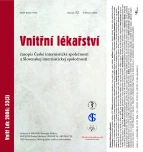Effect of administration of Escherichia coli Nissle (Mutaflor) on intestinal colonisation, endo-toxemia, liver function and minimal hepatic encephalopathy in patients with liver cirrhosis
Authors:
J. Lata 1; J. Juránková 2; V. Příbramská 1; P. Frič 3; M. Šenkyřík 1; Petr Dítě 1; R. Kroupa 1
Authors‘ workplace:
Interní gastroenterologická klinika Lékařské fakulty MU a FN Brno, pracoviště Bohunice, přednosta prof. MUDr. Petr Dítě, DrSc.
1; Oddělení klinické mikrobiologie FN Brno, pracoviště Bohunice, přednostka prim. MUDr. Alena Ševčíková
2; Interní klinika Ústřední vojenské nemocnice, Praha, přednosta doc. MUDr. Miroslav Zavoral, Ph. D.
3
Published in:
Vnitř Lék 2006; 52(3): 215-219
Category:
Original Contributions
Overview
The purpose of the study was to verify effects of Escherichia coli Nissle (Mutaflor) on intestinal colonisation, endotoxin levels, hepatic encephalopathy and liver function in patients with liver cirrhosis. The study involved 39 patients (22 taking Mutaflor and 17 taking placebo). Even though the number combination test showed extended reaction time in patients with described minimal hepatic encephalopathy the drop was not significant in the trend evaluation. However, the treated group displayed significant improvement of intestinal colonisation (p < 0.001) and a trend towards significant reduction of endotoxin levels on day 42 (p = 0.07) and improvement of liver function assessed with the Child-Pugh classification on days 42 and 84 (p = 0.06). Probiotic preparations can therefore represent a significant contribution to this group therapy.
Key words:
liver cirrhosis – pro-biotic – Eschericha coli Nissle – endotoxin – hepatic encephalopathy
Sources
1. Sood GK, Sarin SK, Mahaptra J et al. Comparative efficacy of psychometric tests in detection of subclinical hepatic encephalopathy in nonalcoholic cirrhotics: search for a rational approach. Am J Gastroenterol 1989; 84: 156-159.
2. Bauer TM, Schwacha H, Steinbruckner B et al. Small intestinal bacterial overgrowth in human cirrhosis is associated with systemic endotoxemia. Am J Gastroenterol 2002; 97: 2364-2370.
3. Murray P, Baron E, Phaller M. Manual of clinical microbiology. Washington DC: American Society for Microbiology 1999.
4. Metchnikoff E. Prolongation of life. New York: Putnam 1908.
5. Döderlein A. Das Scheidensekret und seine Bedeutung für das Puerperalfieber. (The vaginal transsudate and its significance for childbed fever.) Centralblatt für Bacteriologie 1892; 11: 699-700.
6. Cahn DR. Über die nach Gram färbbaren Bacillen des Säulingsstuhles (Bacilli of infant stools stainable according to Gram.) Centralblatt für Bakteriologie I. Abteilung Originale 1901; 30: 721-726.
7. Lilly DM, Stillwell RH. Probiotics: growth promoting factors produced by microorganisms. Science 1965; 147: 747-748.
8. Fuller R. Probiotics in man and animals. J Appl Bacteriol 1989; 66: 365-378.
9. Havenaar R, Ten Brink B, Huis in't Veld JHJ. Selection of strains for probiotic use. In: Fuller R (ed). Probiotics: the scientific basis. London: Chapman and Hall, 1992: 209-224.
10. Sartor RB. Probiotic therapy of intestinal inflammation and infections. Curr Opin Gastroenterol 2005; 21: 44-50.
11. Fooks LJ, Gibson GR. Probiotics as modulators of the gut flora. Brit J Nutrition 2002; 88: S39-S49.
12. Frič P. Probiotika v gastroenterologii. Aktuální přehled. Čes a slov gastroent a hepatol 2001; 55: 237-241.
13. Thalheimer U, Triantos CK, Samonakis DN et al. Recent advances in clinical practice - Infection, coagulation and variceal bleeding in cirrhosis. Gut 2005; 54: 556-563.
14. Liu Q, Duan ZP, Ha DK et al. Synbiotic modulation of gut flora: effect on minimal hepatic encephalopathy in patients with cirrhosis. Hepatology 2004; 39: 1441-1449.
15. Wu CD, Li MZ, Chen CL et al. Endotoxin-induced liver injury and plasma tumor necrosis factor alfa, interleukin 6 level changes in rabbits. Chin J Dig 1995; 15: 256-258.
16. Hai YZ, Hui JW, Zhi L et al. Intestinal microflora in patients with liver cirrhosis. Chin J Dig Dis 2004; 5: 64-72.
17. Loguericio C, Federico A, Tuccillo C et al. Beneficial effects of probiotic VSL#3 on parameters of liver dysfunction in chronic liver diseases. J Clin Gastroenterol 2005; 39: 540-543.
18. Brůha R, Mareček Z. Esenciální fosfolipidy v léčbě jaterní encefalopatie. Vnitř Lék 2000; 46: 199-204.
19. Brůha R, Mareček Z, Petrtýl J et al. Jaterní encefalopatie - komplikace jaterní cirhózy. Praha: Medprint 2000.
20. Boča M, Vyskočil M, Mikulecký M et al. Komplexná liečba chronickej hepatálnej encefalopatie doplnená probiotikom. Čas Lék Čes 2004; 143: 324-328.
Labels
Diabetology Endocrinology Internal medicineArticle was published in
Internal Medicine

2006 Issue 3
Most read in this issue
- Effect of administration of Escherichia coli Nissle (Mutaflor) on intestinal colonisation, endo-toxemia, liver function and minimal hepatic encephalopathy in patients with liver cirrhosis
- Extension of QT interval as a consequence of risk factor accumulation – case study
- Immunoglobulin A and renal diseases
- Non-invasive ventilation support in patients with acute exacerbation of chronic obstructive pulmonary disease (COPD)
